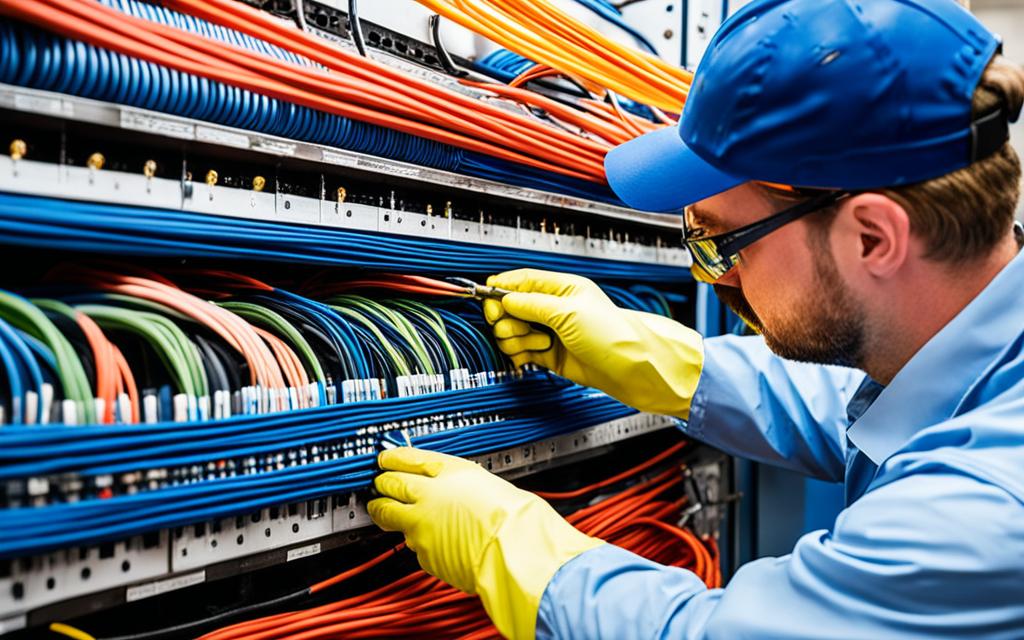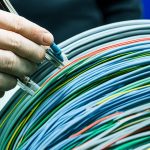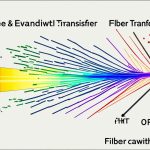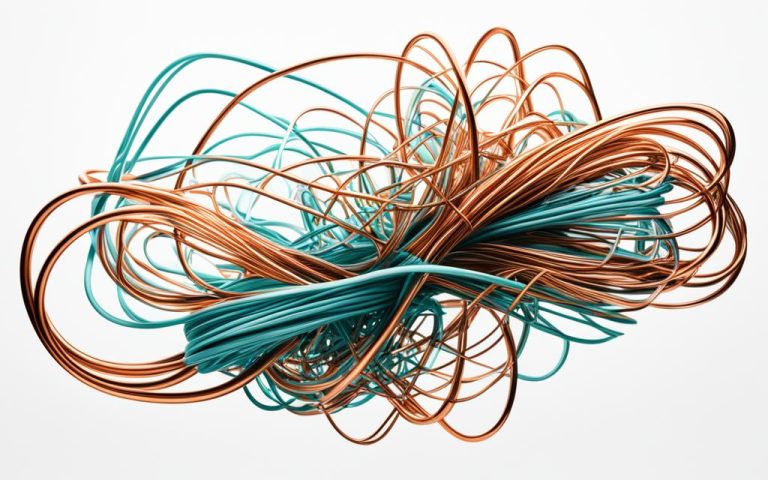Fiber optic network deployment is subject to various regulations and standards that govern the design, installation, and maintenance of these networks. Staying abreast of these regulations is crucial for ensuring compliant infrastructure deployment.
Recent updates and developments have been observed in international ISO/IEC and North American TIA fiber infrastructure standards, as well as IEEE 802.3 Ethernet and Fibre Channel application standards. These updates include revision and restructuring projects within IEC Technical Committee (TC) 86, ongoing efforts to improve accuracy of loss measurements within SC 86B working groups, and the approval of the latest edition of IEC 61280-1-4 for encircled-flux measurement method for multimode fibers.
Similar developments have also been seen in ISO/IEC JTC1/SC25 and TIA’s TR-42.11 Subcommittee on Fiber Optic Systems. It is essential for organizations to stay informed about these regulations and standards to ensure compliance in fiber optic network deployment.
International Standards and Regulations for Fiber Optic Networks
The international front of fiber optic network regulations and standards is governed by various organizations and committees. One of the key organizations responsible for developing these standards is the International Electrotechnical Commission (IEC) Technical Committee (TC) 86. This committee plays a vital role in preparing guidelines and specifications for fiber-optic systems, modules, devices, and components. It comprises three main subcommittees:
- SC 86A (Fibers and Cables): This subcommittee focuses on fiber measurement methods, test procedures, and general specifications for fiber cables.
- SC 86B (Interconnecting Devices and Passive Components): The activities within this subcommittee’s working groups involve developing specifications for environmental testing of components and visual inspection of fiber connector endfaces.
- SC 86C (Systems and Active Devices): The working group under SC 86C addresses fiber-optic systems and active devices.
Recently, significant developments have been made in fiber optic network standards. For example, the latest edition of the IEC 61280-1-4 standard was approved by SC 86C. This standard introduces the encircled-flux measurement method for multimode fibers, which aids in accurate fiber measurement and testing. These international standards and regulations play a crucial role in shaping the deployment of fiber optic networks worldwide.
To better understand the organizational structure and the activities within the IEC TC 86, refer to the following table:
| IEC Technical Committee 86 Subcommittees | Main Activities |
|---|---|
| SC 86A (Fibers and Cables) | Fiber measurement methods, test procedures, general specifications for fiber cables, and related activities. |
| SC 86B (Interconnecting Devices and Passive Components) | Specifications for environmental testing of components and visual inspection of fiber connector endfaces. |
| SC 86C (Systems and Active Devices) | Fiber-optic systems and active devices, including the recent approval of the encircled-flux measurement method for multimode fibers. |
By adhering to these international standards and regulations, organizations can ensure the smooth and efficient deployment of fiber optic networks, enabling robust and reliable communication systems.
North American Regulations and Standards for Fiber Optic Networks
In North America, the Telecommunications Industry Association (TIA) is responsible for developing and maintaining standards for cabling infrastructure, including fiber optic systems. The TR-42.11 Subcommittee on Fiber Optic Systems, under the TIA, plays a crucial role in setting these standards. One of the widely recognized standards published by the TR-42.11 Subcommittee is the TIA-568 series, which covers optical fiber cabling and component requirements.
A notable recent development in North American regulations is the TIA-568.3-E standard, which focuses on fiber transitions and polarity methods. This standard introduces various updates and advancements to enhance the deployment of fiber optic networks in the region.
Among the significant changes in the TIA-568.3-E standard are:
- The designation of the color green for multimode angled physical contact (APC) MPO connectors, providing visual identification and facilitating compatibility with other systems
- Revised trunk cables pinning, ensuring consistent and reliable connections in fiber optic systems
- The introduction of Type-U1 and Type-U2 fiber transitions for MPO-to-LC breakout cables and modules, offering more flexibility and versatility in network configurations
These updates in North American regulations and standards, driven by the TIA and its TR-42.11 Subcommittee, contribute to the continuous improvement and widespread adoption of fiber optic network deployments. Compliance with these standards ensures compatibility, reliability, and optimal performance of fiber optic systems in the region.
| TIA-568.3-E Updates | Impact |
|---|---|
| Designation of color green for multimode angled physical contact (APC) MPO connectors | Visual identification and compatibility with other systems |
| Revised trunk cables pinning | Consistent and reliable connections in fiber optic systems |
| Introduction of Type-U1 and Type-U2 fiber transitions for MPO-to-LC breakout cables and modules | Flexibility and versatility in network configurations |
Safety Protocols for Fiber Optic Network Installation in the European Union
Safety protocols are essential during the installation of fiber optic cables and network infrastructure in the European Union. These protocols are designed to protect technicians, prevent accidents, and ensure the reliability of installed systems.
- Personal Protective Equipment (PPE): Technicians must wear appropriate PPE, including safety glasses, gloves, and reflective vests, to protect themselves from potential hazards.
- Worksite Hazard Assessment: Before starting the installation, a thorough worksite hazard assessment should be conducted to identify potential risks and take necessary precautions.
- Proper Cable Routing and Securement: Cables should be routed and secured properly to avoid tripping hazards and damage to the cables.
- Adherence to Electrical Safety Standards: Electrical safety standards must be followed when working with fiber optic cables to prevent electrical hazards and ensure safe installations.
- Safe Use of Tools and Equipment: Technicians should be trained on the safe use of tools and equipment to minimize the risk of accidents and injuries.
- Clear Emergency Procedures: Clear emergency procedures should be established and communicated to all team members, ensuring a prompt and effective response in case of emergencies.
- Consideration of Environmental Regulations: Environmental regulations should be taken into account to ensure compliance with local and EU regulations related to waste disposal and environmental protection.
- Effective Communication and Coordination: Communication and coordination among team members are crucial for maintaining a safe working environment during the installation process.
- Compliance with Local and EU Regulations: It is essential to comply with local and EU regulations governing fiber optic network installation to ensure legal and regulatory compliance.
By adhering to these safety protocols, a secure working environment can be created for fiber optic network installation, safeguarding the well-being of technicians and the functionality of the installed systems.

Key Safety Rules for Working with Fiber Optic Cables
When working with fiber optic cables, it is crucial to adhere to key safety rules to prevent hazards and ensure the well-being of technicians. By following these rules, you can minimize risks and maintain a safe working environment for fiber optic cable installations. Here are some essential safety rules to abide by:
- Know the Applicable Standards and Regulations: Familiarize yourself with the relevant standards and regulations governing fiber optic cable installation. Stay updated on the latest guidelines to ensure compliance and best practices.
- Maintain a Clean Workspace: Keep your workspace clean and organized to control hazardous glass fragments. Properly dispose of any discarded cables or broken fibers to prevent injuries.
- Understand Chemical Handling: Take the time to understand the chemicals used in the splicing and termination processes. Follow proper handling procedures and ensure proper ventilation when working with any potentially hazardous materials.
- Be Aware of the Work Environment: Before starting any fiber optic cable installation, assess the work environment for potential hazards. Identify any sources of electrical currents or other dangers that could interfere with the installation process.
- Use the Right Tools: Always use the proper tools for the job. Using incorrect or outdated tools can increase the risk of accidents and damage to the cables. Ensure that your tools are in good working condition and appropriate for the specific task.
- Follow Proper Handling Procedures for Fiber Optics: Handle fiber optic cables with care to avoid unnecessary damage. Avoid bending the cables beyond their minimum bend radius and be cautious of sharp edges that could cause cuts or injuries.
By adhering to these safety rules, you can create a secure working environment for fiber optic cable installations. Prioritize safety and ensure that all technicians are trained and knowledgeable about these safety protocols.

Remember, safety is of utmost importance when working with fiber optic cables. By following these guidelines, you can minimize risks, ensure compliance with safety standards, and protect both yourself and the integrity of the installed systems.
Importance of Regular Safety Training and Certification
Regular safety training and certification are crucial for technicians working with fiber optic cables. This training ensures that technicians are equipped with the latest safety procedures and industry best practices, promoting a culture of safety in the workplace. Through safety training, technicians gain knowledge and skills in various aspects of occupational safety and health, enabling them to prevent, identify, and address potential hazards.
Hazard identification: Safety training familiarizes technicians with different types of hazards they may encounter while working with fiber optic cables. This includes electrical hazards, chemical exposure risks, and physical accidents. By understanding these hazards, technicians can take proactive measures to mitigate potential risks.
Personal protective equipment (PPE) usage: Safety training emphasizes the importance of using appropriate PPE to protect against potential hazards. Technicians are trained on the proper selection, use, and maintenance of PPE such as safety goggles, gloves, and protective clothing.
Emergency procedures: Safety training covers emergency response protocols, ensuring that technicians are prepared to handle unforeseen situations. This includes knowledge of evacuation procedures, first aid techniques, and proper reporting of incidents.
Compliance with occupational safety and health regulations: Safety training provides technicians with a comprehensive understanding of regulatory requirements and standards in the field of occupational safety and health. Technicians learn about their rights and responsibilities, as well as the consequences of non-compliance. By adhering to these regulations, organizations and technicians can avoid penalties and legal liabilities.
Certification is a formal recognition of a technician’s competence and adherence to safety standards. It validates their knowledge and skills in implementing safety protocols and procedures. Certified technicians inspire confidence among clients and employers, showcasing their commitment to maintaining a safe work environment and ensuring regulatory compliance.
Organizations and technicians must prioritize safety training and certification to mitigate risks, protect the well-being of technicians, and ensure compliance with occupational safety and health regulations. By investing in safety education, organizations demonstrate their commitment to employee welfare and promote a culture of safety in the fiber optic industry.
Conclusion
Navigating the complex landscape of fiber optic network regulations and standards is paramount for organizations seeking to ensure compliant infrastructure deployment. International bodies, such as the International Electrotechnical Commission (IEC) and International Organization for Standardization/International Electrotechnical Commission (ISO/IEC), play a pivotal role in developing and updating standards for fiber optic systems, modules, devices, and components. For organizations operating in North America, the Telecommunications Industry Association (TIA) assumes a significant responsibility for establishing and maintaining standards in the region.
During the installation of fiber optic networks, adherence to safety protocols is crucial to protect technicians and uphold the reliability of the installed systems. Organizations must prioritize safety rules, encompassing practices such as personal protective equipment usage, hazard identification, and proper handling procedures for fiber optics. Regular safety training and certification are vital to equip technicians with the latest knowledge and best practices, ensuring compliance with occupational safety and health regulations.
By staying knowledgeable about the evolving regulations and diligently following safety guidelines, organizations can successfully navigate the regulatory landscape and deploy fiber optic networks efficiently and compliantly. Embracing industry standards, adhering to safety protocols, and investing in continuous education will allow organizations to thrive and build a robust fiber optic infrastructure that meets the demands of today and tomorrow.
FAQ
What are fiber optic network regulations and standards?
Fiber optic network regulations and standards are guidelines and requirements that govern the design, installation, and maintenance of fiber optic networks. They ensure compliant infrastructure deployment and ensure compatibility and reliability.
Which organizations develop international fiber optic network standards?
The International Electrotechnical Commission (IEC) and the International Organization for Standardization/International Electrotechnical Commission (ISO/IEC) develop and update international standards for fiber optic systems, modules, devices, and components.
What is the role of the IEC Technical Committee 86 in fiber optic network standards?
The IEC Technical Committee 86 is responsible for preparing standards for fiber-optic systems. It includes subcommittees that focus on fibers and cables, interconnecting devices and passive components, and systems and active devices.
Which organization develops and maintains fiber optic network standards in North America?
The Telecommunications Industry Association (TIA) is responsible for developing and maintaining standards for fiber optic systems in North America.
What are some important North American regulations and standards for fiber optic networks?
The TIA’s TR-42.11 Subcommittee on Fiber Optic Systems has published standards such as the TIA-568 series, which cover requirements for optical fiber cabling and components. TIA-568.3-E standard pertains to fiber transitions and polarity methods.
What are some safety protocols for fiber optic network installation in the European Union?
Safety protocols in the EU include the use of personal protective equipment, thorough worksite hazard assessment, adherence to electrical safety standards, proper cable routing, clear emergency procedures, compliance with local and EU regulations, and effective communication and coordination among team members.
What are some key safety rules for working with fiber optic cables?
Key safety rules include knowing applicable standards and regulations, maintaining a clean workspace to control hazardous glass fragments, understanding chemicals used in splicing and termination processes, being aware of potential hazards, using the right tools, and following proper handling procedures.
Why is regular safety training and certification important for technicians working with fiber optic cables?
Regular safety training ensures technicians are aware of the latest safety procedures and best practices in the industry. Certification validates their knowledge and skills in adhering to safety standards, mitigating risks, and ensuring compliance with regulations.
How can organizations navigate fiber optic network regulations and standards?
Organizations can stay informed by keeping up with updates from international organizations like the IEC and ISO/IEC and staying updated on North American regulations from the TIA. Adhering to safety rules, providing regular safety training, and prioritizing certification also help ensure compliance.



















